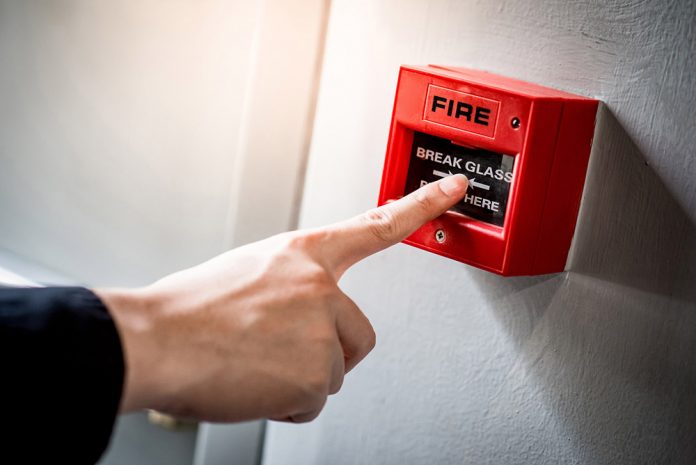Richard Jenkins, Chief Executive of the National Security Inspectorate, explains the important responsibilities Chamber business owners/managers must fulfil covering mandatory life safety fire risk assessments at any commercial site. He sets out how, as legally identified ‘Duty Holders’, they can best discharge these legal responsibilities and simultaneously satisfy related insurance requirements
There’s no getting around these two basic facts: one, Scottish business owners/managers are likely to be the legally identified ‘Duty Holder’ tasked with ensuring, firstly, that a ‘life safety fire risk assessment’ is carried out on their premises; and two, they are required to ensure the findings of the assessment are implemented.
In practical terms, this means any fire safety shortcomings or recommendations identified must be carried out in full, as specified, and completed within the stipulated timeframe. The results of a mandatory life safety fire risk assessment may require, for example, the implementation of fire safety protections including fire detection, extinguishing and alarm systems, and emergency evacuation procedures.
In terms of inspections and enforcement action, the Scottish Fire & Rescue Service might visit your premises to check the fire risk assessment and related prevention measures are appropriate. As a result, you could receive an Enforcement Notice. This would occur if it were considered a serious risk was not being managed. The Notice, if issued, would detail the improvements needed – and by when.
Penalties can include fines and two years in prison. On top of that, reputational harm in this era of fast and uncontrolled commentary via social media can be damaging – the implicit assumption on social media being there’s ‘no smoke without fire’.
Conducting a fire risk assessment
Responsibility for fire safety in a building rests with the ‘Duty Holder’ in a wide spectrum of non-domestic premises. The definitions of those responsible are contained within the Regulatory Reform (Fire Safety) Order 2005 – introduced in England and Wales in October 2006 – the Fire (Scotland) Act 2005, and the F&RS (NI) Order 2006 / Fire Safety Regulations 2010.
In essence, life safety fire risk assessment (LSFRA) protects lives and is central to establishing sufficient fire prevention, protection and suppression measures, alongside safe evacuation procedures that can be applied in the event of an incident.
Assessment is best conducted once a building is occupied and operational. Building use changes over time. LSFRA is only meaningful in the context of current use, as well as the integrity of physical elements such as escape routes and fire doors. Where five or more people are employed the results of LSFRAs must be documented and all assessments must be periodically reviewed to ensure they remain valid, for example when any change of use is implemented.
Identifying the ‘Duty Holder’
The Duty Holder can be anyone with control and/or oversight of a premises. In the majority of instances, it is considered the responsibility of each employer to safeguard their staff, patients and visitors. The Duty Holder has to work together with all other parties, such as an external facilities management provider or assigned contractor(s), to ensure the requirements of the LSFRA are met.
Where maintenance of a building (including regular fire alarm testing, portable fire extinguisher and other routine maintenance) is undertaken by a facilities management provider, or another external contractor, the Duty Holder must maintain a close working relationship with them to ensure required maintenance procedures are being adequately discharged, and that any changes in use are reflected in the siting and maintenance of safety equipment.
Competent assessments
Perhaps surprisingly, fire safety legislation does not define fire risk assessor ‘competence’. Government guidance states that where identified Duty Holders are unwilling or unable to complete an LSFRA they should seek the advice of a competent person. The guidance recommends assessments be conducted by a person with comprehensive training and experience in the type of fire risk assessment they are being asked to carry out.
Where Duty Holders are seeking competent assessors, third party certificated or approved providers can provide significant reassurance for those seeking help to meet their fire safety obligations. Approved LSFRA providers all commit to an independent on-going audit programme to verify their competency. Holding approval from a UKAS (United Kingdom Accreditation Service)-accredited independent certification body such as NSI (which is licensed to deliver the BAFE Life Safety Fire Risk Assessment Scheme SP205) provides evidence of their competence to conduct fire risk assessments and clearly demonstrates their services are compliant with current appropriate industry standards and best practice.
Conclusion – final steps
Ensuring all appropriate fire safety measures are adequately identified and periodically reviewed by risk assessment is the primary task of the Duty Holder. Following this up to ensure measures are effectively implemented is key. Where changes in building use and working practices have occurred – say as a result of Covid-19 – these should be considered in any competent fire risk assessment review.
Requesting third party certificated/approved LSFRA providers to review measures in place can help Duty Holders ensure they effectively fulfil both their legal responsibilities and insurance requirements and demonstrate their commitment to the safety of their staff, customers and visitors to the space they oversee.
UKAS accredited NSI is a leading independent third party certification body within the UK’s fire safety, security systems and guarding services sectors.






